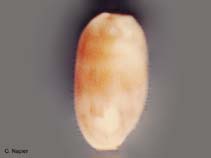Cypraea isabella Linnaeus, 1758
Isabelle cowrieWarning: DOMDocument::load(): SSL operation failed with code 1. OpenSSL Error messages: error:140770FC:SSL routines:SSL23_GET_SERVER_HELLO:unknown protocol in C:\Apache24\htdocs\includes\SpeciesSummary.lib.php on line 1236
Warning: DOMDocument::load(): Failed to enable crypto in C:\Apache24\htdocs\includes\SpeciesSummary.lib.php on line 1236
Warning: DOMDocument::load(https://sealifebase.nrm.se/webservice/AquaMaps/getAMap.php?genus=Cypraea&species=isabella): failed to open stream: operation failed in C:\Apache24\htdocs\includes\SpeciesSummary.lib.php on line 1236
Warning: DOMDocument::load(): I/O warning : failed to load external entity "https://sealifebase.nrm.se/webservice/AquaMaps/getAMap.php?genus=Cypraea&species=isabella" in C:\Apache24\htdocs\includes\SpeciesSummary.lib.php on line 1236
Classification / Names Common names | Synonyms | CoL | ITIS | WoRMS
| Littorinimorpha | Cypraeidae
Environment: milieu / climate zone / depth range / distribution range Οικολογία
; εύρος βάθους 0 - 35 m (Ref. 349). Tropical
Κατανομή Χώρες | Περιοχές FAO | Οικοσυστήματα | Παρουσίες | Εισαγωγές
Indo-Pacific: East Africa to eastern Polynesia. Tropical and subtropical.
Length at first maturity / Μέγεθος / Βάρος / Age
Maturity: Lm ? range ? - ? cm Max length : 5.5 cm SHL αρσενικό/απροσδιόριστο; (Ref. 349); common length : 4.0 cm SHL αρσενικό/απροσδιόριστο; (Ref. 349)
Locally collected for food. Shell used for shellcraft (Ref. 349). Also found in shallow subtidal zones. Dead shells found on the beaches (Ref. 88739). Near coral reefs (Ref. 799). Members of the family Cypraeidae are primarily carnivores (Ref. 67623).
Life cycle and mating behavior Γεννητική Ωρίμανση | Αναπαραγωγή | Γεννοβολία | Αβγά | Γονιμότητα | Προνύμφες
Members of the order Neotaenioglossa are mostly gonochoric and broadcast spawners. Life cycle: Embryos develop into planktonic trocophore larvae and later into juvenile veligers before becoming fully grown adults.
Main reference
Αναφορές | Συντονιστής | Συνεργάτες
Poutiers, J.M. 1998. (Ref. 349)
IUCN Red List Status (Ref. 130435)
CITES status (Ref. 108899)
Not Evaluated
CMS (Ref. 116361)
Not Evaluated
Threat to humans
Harmless
Human uses
| FishSource |
Εργαλεία
Περισσότερες πληροφορίες
Διαδικτυακές πηγές
BHL | BOLD Systems | CISTI | DiscoverLife | FAO(Publication : search) | Fishipedia | GenBank (genome, nucleotide) | GloBI | Gomexsi | Google Books | Google Scholar | Google | PubMed | Δέντρο Ζωής | Wikipedia (Go, αναζήτηση) | Zoological Record
Estimates based on models
Preferred temperature
(Ref. 115969): 23.8 - 29.3, mean 28.4 (based on 3800 cells).
Price category
(Ref. 80766):
Unknown.



